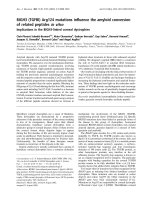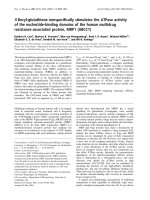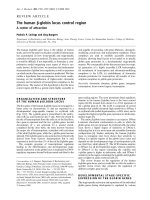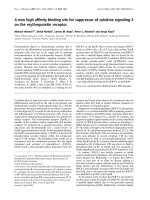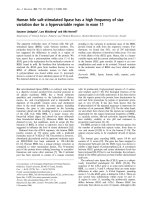Báo cáo y học: "F-18 fluorodeoxyglucose positron emission tomography and/or computed tomography findings of an unusual breast lymphoma case and concurrent cervical cancer: a case report" docx
Bạn đang xem bản rút gọn của tài liệu. Xem và tải ngay bản đầy đủ của tài liệu tại đây (1.42 MB, 5 trang )
CAS E REP O R T Open Access
F-18 fluorodeoxyglucose positron emission
tomography and/or computed tomography
findings of an unusual breast lymphoma case
and concurrent cervical cancer: a case report
Nghi C Nguyen
1*
, Christopher N Hueser
2
, Aarti Kaushik
1
, Hussein R Farghaly
1
, Medhat M Osman
1
Abstract
Introduction: Breast lymphoma accounts for less than 1% of all non-Hodgkin’s lymphomas and approximately
0.1% of all breast neoplasms. Most breast lymphomas are classified as diffuse large B-cell lymphomas or as mucosa
associated lymphoid tissue lymphomas. Concu rrent cases of breast lymphoma and cervical cancer are extremely
rare.
Case presentation: We report a case of a 46-year-old woman of unknown ethnic origin diagnosed with
concurrent diffuse large B-cell lymphoma of the breast and squamous cell cancer of the cervix that was detected
and followed with F-18 fluorodeoxyglucose (FDG) positron emission tomography and/or computed tomography
(PET/CT). The metastatic pattern of this case of breast lymphoma is similar to that of a typical metastatic breast
carcinoma. These findings have never been described in the literature. PET/CT also demonstrated an incidentally
intense FDG focus in the uterine cervix ultimately leading to the pathologic diagnosis of squamous cell carcinoma
of the uterine cervix. An appropriate staging of breast lymphoma and cervical cancer with FDG PET/CT is
important because of therapeutic consequence. This case report and review of the literature highlights the role of
FDG PET/CT in staging and restaging of both breast lymphoma and cervical cancer.
Conclusions: We report a case of a breast lymphoma with a metastatic pattern similar to that of typical metastatic
breast carcinoma. The FDG PET/CT scan also diagnosed a rare case of concurrent breast lymphoma and cervical
cancer. This concurrence has not been reported previously in the medical literature.
Introduction
Breast lymphoma accounts for less than 1% of all cases of
patients with non-Hodgkin’s lymphomas (NHL) [1] and
approximately 0.1% of all cases of patients with breast neo-
plasms [2]. Most breast lymphomas are either classified as
diffuse large B-cell (DLBC) lymphomas (as with the case
of our patient) or as mucosa associated lympho id tissue
(MALT) lymphomas. The prevalence of breast lymphoma
is much less compared to that of cervical cancer. In the
USA, there were an estimated 11,070 new cases of invasive
cervical cancer in 2008. As a result, 3870 cancer-related
deaths are expected. This represents approximately 1% of
cancer deaths in women [3]. 18-Fluorodeoxy glucose
(FDG) positron emission tomo graphy and/or computed
tomography (PET/CT) has been shown to be useful in the
diagnosis, staging and restaging of various cancers with
accuracies ranging from 80% to 90% [4].
We describe the staging and restaging findings of FDG
PET/CT scans in a patient with synchronous breast lym-
phoma and cervical cancer and highlight this rare clini-
cal occurrence. To the best of our knowledge,
concurrent breast lymphoma and cervical cancer have
not been reported in the literature.
Case presentation
A 46-year-old woman of unknown ethnic origin pre-
sented to her primary doctor with a one-month history
* Correspondence:
1
Department of Radiology, Division of Nuclear Medicine, Saint Louis
University, 3635 Vista Avenue (at Grand Avenue), Saint Louis, MO, 63110,
USA
Full list of author information is available at the end of the article
Nguyen et al. Journal of Medical Case Reports 2010, 4:282
/>JOURNAL OF MEDICAL
CASE REPORTS
© 2010 Nguyen et al; licensee BioMed Central Ltd. This is an Open Access article distributed under the terms of the Creative Commons
Attribution License ( which permits unrestricted use, distribution, and reproduction in
any me dium, provided the original work is properly cited.
of a painless left breast lump without associated nipple
discharge that was noticed by the doctor on examina-
tion. She was otherwise healthy with no other relevant
history. Physical examination revealed a large, non-ten-
der, freely movable mass in the left breast and multiple
enlarged lymph nodes in the l eft axilla. Our patient
reported no systemi c B symptoms such as fever or
weight loss. A biopsy of her left breast mass revealed a
DLBC lymphoma. Our patient was then referred for sta-
ging with F-18 FDG PET/CT that was acquired from
base of skull to upper thigh with the CT being low-dose
and unenhanced. The PET/CT scan revealed a 8 × 10
cm hyperdens e and intensely FDG-avid mass occupying
almost the entire left breast with maximum standard
uptake value (SUV) of 21 (Figure 1). In addition, several
left axillary lymph nodes measuring up to 5 cm in size
and several left sub-centimeter internal mammary
lymph nodes showed intense FDG avidity (Figure 2),
with SUV value s of 33 and 3.3. However, PET/CT find-
ings were suggestive a breast carcinoma rathe r than a
lymphoma, based on the location and distribution of the
lesion. Because of the rarity of breast lymphoma, it
would be unusual to consider metastatic breast lym-
phoma in the differential diagnosis of breast tumors. As
a result, it would have been impossible to distinguish
breast lymphoma from breast carcinoma through PET/
CT. An incidental finding of intense FDG uptake in the
uterine cervix, SUV of 8, led to the subsequent patholo-
gicdiagnosisofapreviouslyunsuspectedsquamouscell
carcinoma (Figure 3). The lesion appeared to involve the
proximal third of the vagina and the corpus uterine, but
a t umor extension to the parametrial soft tissue was not
noticed.
Our patient underwent chemotherapy for NHL of the
breast and cervical cancer as well as afterloading bra-
chytherapy to the uterine cervix. A repeat FDG PET/CT
three months after completion of therapy showed
resolved FDG avidity of all previously described lesions
(Figures 1, 2, 3).
Discussion
Breast lymphoma
DLBC lymphoma is an NHL that usually presents with a
rapidly enlarging mass. Systemic B symptoms (that is
fever a nd weight loss >10% of body weight) may occur
in approximat ely 30% of patients [5]. Large B-cell lym-
phoma is the most comm on type of NHL; its prevalence
is about 30% of all NHL patients. Also, large B-cell lym-
phoma accounts for approximately 40% of patients with
extra-nodal NHL [2,6]. Extra-nodal sites may be of lung,
pleura, thymus, breast, spleen, liver, pancreas, musculos-
keletal system, or central nervous system [2]. Primary
breast lymphoma is a rare disease and presented only
0.1% of the more than 25,000 primary malign ant tumors
of the breast treated during a 30-year period in a single
institution [6].
There are only a few reports of FDG-PET findings of
extra-nodal breast lymphoma [ 7-10]. Kumar et al.
Figure 1 (A) Axial computed tomography (CT) and (B) axial positron emission tomography (PET) images of pre-treatment PET/CT scan
showed an intense FDG avid mass in the left breast (arrowhead). (C) Axial computed tomography (CT) and (D) axial positron emission
tomography (PET) images of post-treatment PET/CT, three months after completion of chemotherapy, showed resolution of previously
fludeoxyglucose (FDG) avid breast lesion.
Nguyen et al. Journal of Medical Case Reports 2010, 4:282
/>Page 2 of 5
repo rted the findings of FDG-PET in a case of a patient
with DLBC lymphoma that presented as intense and dif-
fuse FDG uptake in dense breast tissue and was not
detectable by diagnostic CT [7]. Bakheet et al.reported
a patient with breast lymphoma mass that had intense
FDG uptake in the rim and photopenic center sugges-
tive a tumor with central necrosis [8]. Nihashi et al.
described the FDG uptake as intens e, round and homo-
geneous, but, unfortunately, there were no CT images
for correlation [9]. Another case reported a patient with
Figure 2 Maximum intensity projection (MIP) PET images: (A) Pre-therapy scan again showed the fludeoxyglucose (FDG) avid mass
occupying almost the entire left breast (large arrowhead), further left axillary lymph node conglomerates (short arrow) and two left internal
mammary lymph nodes (long arrows), all demonstrating high FDG avidity. An intense FDG focus in the right pelvic sidewall (small arrowhead)
was a corpus luteal cyst verified by diagnostic computed tomography (CT) and ultrasound. Three months after completion of chemotherapy, a
PET/CT scan (B) showed resolved FDG avidity of all previously described lesions in the left breast, left axilla and left internal mammary region,
suggestive of complete remission of breast lymphoma. Spontaneous resolution of the corpus luteal cyst was also noticed.
Figure 3 (A) Axial computed tomography and (B) axial positron emission tomography images of pre-treatment PET/CT scan showed
an intense FDG focus in the uterine cervix (short arrow) with soft tissue fullness on CT (long arrow). (C) Axial CT and (D) axial PET
images of post-treatment PET/CT, three months after completion of chemotherapy, showed resolution of previously FDG avid cervical lesion.
Nguyen et al. Journal of Medical Case Reports 2010, 4:282
/>Page 3 of 5
concurrent breast lymphoma and multiple nodular ade-
nosis [10]. In that case, an FDG PET scan after one
cycle of chemotherapy showed diffuse moderate FDG
uptake in the right breast which might have reflected
good response to therapy based on FDG intensity. In
the current case, a large, intensely FDG avid, hyperdense
tumor mass infiltrated almost the entire soft tissue of
the left breast which was not described previously. In
addition, the F DG avid lymph nodes in the ipsilateral
axillary and internal mammary regions showed a meta-
static pattern similar to that of typical metastatic breast
cancer. These findings have not been reported in the
literature.
TheroleofFDGPETinthediagnosis,stagingand
restaging of lymphoma has been established [2,11]. Inte-
grated PET/CT increases the sensitivity and specificity
compared to FDG PET alone. In Hodgkin’slymphoma
or high-grade NHL, the sensitiv ity of PET/CT and con-
trast-enhanced CT for lymph node involvement was
found to be 94% and 88%, respectively, while the specifi-
city was 100% and 86%, respectively [11]. For extra-
nodal disease, PET/CT and contrast-enhanced CT had a
sensitivity of 88% and 50%, and a specificity of 100%
and 90% [11]. The degree of FDG uptake can distinguish
indolent from a ggressive NHL [12]. An SUV >10 was
found to have high likelihood for aggressive disease. In
our patient, SUV was 21 in the breast mass and there
was associated locoregional lymphadenopathy suggestive
of aggressive disease. Early FDG PE T/CT scan c an be
car rie d out after first-line chemotherapy to increase the
prognostic value by assessing the degree of interval SUV
decrease, with event-free survival improving from 65%
to 76% in patients with DLBC lymphoma when quanti-
tative SUV analysis was added to a visual assessment
[13].
The Ann Arbor staging system developed in 1971 f or
Hodgkin’s lymphoma was adapted for staging of NHL
[14]. Based on the present FDG PET/CT findings, our
patient had stage II disease because there was involve-
ment of two lymph node regions on the same side of
the diaphragm besides the primary breast lesion.
Cervical cancer
The incidental detection of a second malignancy in can-
cer patients undergoing FDG PET/CT staging is not
uncommon [15]. However, the FDG PET /CT scan diag-
nosed a rare case of concurrent breast lymphoma and
cervical cancer that has never been reported in the lit-
erature. It seems unlikely, though, t hat the breast lym-
phoma and the cervical cancer of our patie nt are caused
by one or the other.
The Internati onal Federation of Gynecologists and
Obstetricians (FIGO) in collaboration with the World
Health Organization (WHO) and the International
Union Against Cancer (IUCC) are the most common
staging systems for cervical cancer [16]. The FIGO sta-
ging system is largely based upon physical examination.
Thus, a good pelvic examination is important. Tumor
size and parametrial involvement are best assessed by
rectovaginal examination. Colposcopy, cystoscopy, and
proctoscopy can be used to assess adjacent areas.
Optional procedures include ultrasound, CT, magnetic
resonance imaging (MRI), and FDG PET or PET/CT,
and can be of value for treatment planning.
FDG P ET has be en used in initial staging and monitor-
ing of therapy in patients with cervical cancer [17]. In a
review article, the sensitivity and specificity for pelvic
involvement with newly diagnosed cervical cancer were
79% and 99% for FDG-PET, and 72% an d 96% for MRI;
for C T the sensitivity was 47%, the specificity could not
be accurately determined. For para-aortic node metasta-
sis, FDG-PET had a sensitivity of 84%, and a specificity of
95% [17]. The diagnostic accuracy of FDG PET in lymph
node staging, however, might be lower in women with
early stage diseases [18]. This is partly attributed to the
low-dose and unenhanced CT of the PET/CT scan that is
sub-optimal for detecting sub-centimeter nodal disease.
Of note, the CT was sub-optimal in the current patient
as well. But PET/CT scan is increasingly being carried
out with intravenous contrast media.
In our patient, FDG PET/CT findings suggested a T2
tumor that involved the proximal third of the vagina
and the corpus uterine. There was no evidence of para-
metrial tumor invasion. An intensely FDG avid soft tis-
sue density seen in the left pelvis was thought to be
either lymph node metastasis or physiologic ovarian
FDG uptake. Subsequent ultrasound and diagnostic con-
trast-enhanced CT confirmed the presence of a corpus
luteal cyst that sometimes may cause false-positive inter-
pretation because of the FDG avidity [19]. Based on
imaging findings, the cerv ical cancer was T2N0M0,
stageII.ThedegreeofFDGuptakehasprognosticsig-
nificance in cervical cancer and was found to negative ly
correlate with treatment response and prognosis [20].
Conclusions
This case report shows a breast lymphoma case of a
patient with a metastatic pattern similar to that of typi-
cal metastatic breast carcinoma. Also, the FDG PET/CT
scan diagnosed an extremely rare case of concurrent
breast lymphoma and cervical cancer. FDG PET/CT has
advantage over other imaging modalities because of its
whole-body scanning that offers detection of metastasis
and any previously unknown malignancy.
Consent
Written consent for publication could not be obtained
despite all reasonable attempts. All efforts have been
Nguyen et al. Journal of Medical Case Reports 2010, 4:282
/>Page 4 of 5
made to protect the identity of the patient and there is
no reason to believe the patient would object to
publication.
Author details
1
Department of Radiology, Division of Nuclear Medicine, Saint Louis
University, 3635 Vista Avenue (at Grand Avenue), Saint Louis, MO, 63110,
USA.
2
Department of Internal Medicine, Division of Hematology and
Oncology, Saint Louis University, 3635 Vista Avenue (at Grand Avenue), Saint
Louis, MO, USA.
Authors’ contributions
NCN is the senior author and was involved in collecting patient information,
reviewing the literature and doing the final proofreading of the manuscript.
CNH was involved in discussion and editing of the manuscript. HRF and AK
helped capture and prepare the images. MMO contributed to the discussion,
editing and proofreading of the manuscript. All authors read and approved
the final manuscript.
Competing interests
The authors declare that they have no competing interests.
Received: 21 October 2009 Accepted: 20 August 2010
Published: 20 August 2010
References
1. Giardini R, Piccolo C, Rilke F: Primary non-Hodgkin’s lymphomas of the
female breast. Cancer 1992, 69:725-735.
2. Metser U, Goor O, Lerman H, Naparstek E, Even-Sapir E: PET-CT of
extranodal lymphoma. AJR Am J Roentgenol 2004, 182:1579-1586.
3. American Cancer Society, Cancer Facts & Figures 2008. [http://www.
cancer.org/downloads/STT/2008CAFFfinalsecured.pdf].
4. Czernin J, Allen-Auerback M, Schelbert HR: Improvements in Cancer
Staging with PET/CT: Literature-Based Evidence as of September 2006.
J Nucl Med 2007, 48(Suppl 1):78S-88S.
5. The Non-Hodgkin’s Lymphoma Classification Project: A clinical evaluation
of the International Lymphoma Study Group classification of non-
Hodgkin’s lymphoma. Blood 1997, 89:3909.
6. Lopez-Guillermo A, Colomo L, Jimenez M, Bosch F, Villamor N, Arenillas L,
Muntañola A, Montoto S, Giné E, Colomer D, Beà S, Campo E, Montserrat E:
Diffuse large B-cell lymphoma: clinical and biological characterization
and outcome according to the nodal or extranodal primary origin. J Clin
Oncol 2005, 23:2797-2804.
7. Kumar R, Xiu Y, Dhurairaj T, Yu JQ, Alavi A, Zhuang H: F-18 FDG positron
emission tomography in non-Hodgkin lymphoma of the breast. Clin Nucl
Med 2005, 30:246-248.
8. Bakheet SM, Bakheet R, Ezzat A, Tulbah A, Durakovic A, Hussain S: F-18 FDG
positron emission tomography in primary breast non-Hodgkin’s
lymphoma. Clin Nucl Med 2001, 26:299-301.
9. Nihashi T, Hayasaka K, Itou T, Ito K, Kato R, Okae T, Ishigaki T: Findings of
fluorine-18-FDG PET in extranodal origin lymphoma in three cases of
diffuse large B cell type lymphoma. Ann Nucl Med 2006, 20:689-693.
10. Kim MJ, Kim EK, Park SY, Yun M, Oh KK: Multiple nodular adenosis
concurrent with primary breast lymphoma: pitfall in PET. Clin Radiol 2005,
60:126-129.
11. Schaefer NG, Hany TF, Taverna C, Seifert B, Stumpe KD, von Schulthess GK,
Goerres G: Non-Hodgkin lymphoma and Hodgkin disease: coregistered
FDG PET and CT at staging and restaging: do we need contrast-
enhanced CT? Radiology 2004, 232:823-289.
12. Schoder H, Noy A, Gonen M, Weng L, Green D, Erdi YE, Larson SM,
Yeung HW: Intensity of 18-Fluorodeoxyglucose uptake in positron
emission tomography distinguishes between indolent and aggressive
Non-Hodgkin’s lymphoma. J Clin Oncol 2005, 23:4643-4651.
13. Lin C, Itti H, Haioun C, Petegnief Y, Luciani A, Dupuis J, Paone G, Talbot JN,
Rahmouni A, Meignan M: Early 18F-FDG PET for prediction of prognosis
in patients with diffuse large B-cell lymphoma: SUV-based assessment
versus visual analysis. J Nucl Med
2007, 48:1626-1632.
14. Moormeier JA, Williams SF, Golomb HM: The staging of non-Hodgkin’s
lymphomas. Semin Oncol 1990, 17:43.
15. Iğdem S, Okkan S, Unalan B, Iğdem A, Ferhanoğlu B: Cervical cancer
coexisting with small lymphocytic lymphoma detected during positron
emission tomography/computed tomography simulation: a case report.
Eur J Gynaecol Oncol 2008, 29(4):405-407.
16. Benedet JL, Bender H, Jones H, Ngan HY, Pecorelli S: FIGO staging
classifications and clinical practice guidelines in the management of
gynecologic cancers. Int J Gynaecol Obstet 2000, 70:209.
17. Havrilesky LJ, Kulasingam SL, Matchar DB, Myers ER: FDG-PET for
management of cervical and ovarian cancer. Gynecol Oncol 2005, 97:183.
18. Wright JD, Dehdashti F, Herzog TJ, Mutch DG, Huettner PC, Rader JS,
Gibb RK, Powell MA, Feng G, Siegel BA, Grigsby PW: Preoperative lymph
node staging of early-stage cervical carcinoma by [18F]-fluoro-2-deoxy-
D-glucose-positron emission tomography. Cancer 2005, 104:2484.
19. Kim SK, Kang KW, Roh JW, Sim JS, Lee ES, Park SY: Incidental ovarian 18F-
FDG accumulation on PET: correlation with the menstrual cycle. Eur J
Nucl Med Mol Imaging 2005, 32(7):757-763.
20. Kidd EA, Siegel BA, Dehdashti F, Grigsby PW: The standardized uptake
value for F-18 fluorodeoxyglucose is a sensitive predictive biomarker for
cervical cancer treatment response and survival. Cancer 2007, 110:1738.
doi:10.1186/1752-1947-4-282
Cite this article as: Nguyen et al .: F-18 fluorodeoxyglucose positron
emission tomography and/or computed tomography findings of an
unusual breast lymphoma case and concurrent cervical cancer: a case
report. Journal of Medical Case Reports 2010 4:282.
Submit your next manuscript to BioMed Central
and take full advantage of:
• Convenient online submission
• Thorough peer review
• No space constraints or color figure charges
• Immediate publication on acceptance
• Inclusion in PubMed, CAS, Scopus and Google Scholar
• Research which is freely available for redistribution
Submit your manuscript at
www.biomedcentral.com/submit
Nguyen et al. Journal of Medical Case Reports 2010, 4:282
/>Page 5 of 5

